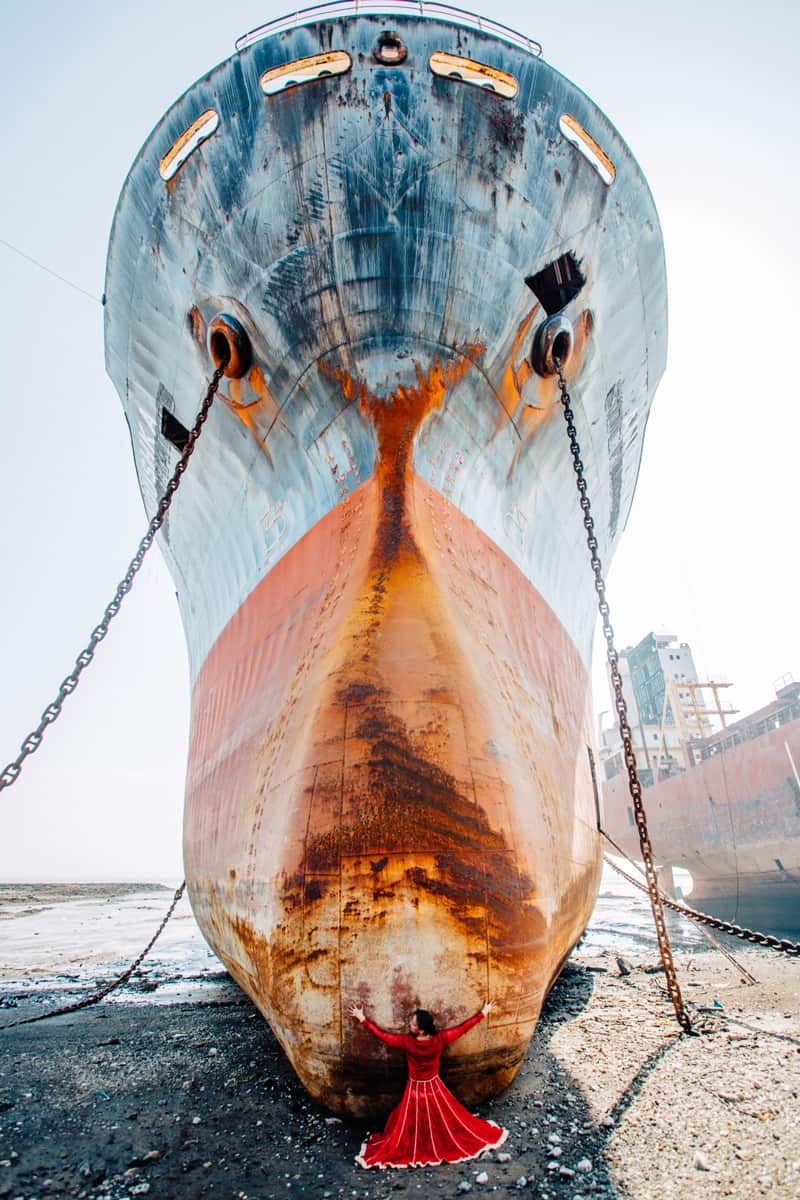Dancer and performance artist Manuela Benini’s ‘The Red Dress Project’ is a corporeal pursuit of the imbalances of power structures and the profound repercussions on those being suppressed.
On display at Sadler’s Wells Theatre, London as part of the Darbar Festival (9‒14 November 2017), Benini’s presentation is an atmospheric and poetic meditation on contemporary Indian life, explored through the traditional kathak storytelling form of dance. Six large-format photographs and a looped video screen see the artist inserting herself into dramatic Indian landscapes in rhythmic and poetic poses, cloaked, as the project’s name would suggest, in red.
The photographs were spread over three floors of the Sadler’s Wells Theatre foyer, seen as the audience climbed higher and higher into the theatre rafters. Two images adorned the walls on each floor, taking a different location on India’s west coast as their focus. Jostling to gain attention from the drama of the already busy walls, unfairly Benini’s meditative works became somewhat lost in all the noise.
‘She is reclaiming the body…’
The body, notably the female body, is Benini’s predominant source material and connecting link in this work. The dancer uses herself as the central and powerful subject. She is reclaiming the body as one’s own, drawing attention to imbalances of power in a time when aggression against women is at the fore of conversation. The ‘personal is political’, a term coined in the 1960s by feminists in order to underscore the connections between personal experiences and a society that allows such values to dominate, seems as unfortunately apt today in Benini’s photographs as it did fifty years previously.
‘Initially…[she] was shrouded in a burqa in order to gain access.’
On the first floor was the Aalang Shipyard, Bhavnagar (Gujarat), an industrial wasteland that looks as dramatic as the story it has to tell. A dumping-ground for the West, this ‘cemetery of boats’, as Benini explains it, contains many of the world’s ships that are sent to die or be recycled. The workers’ life expectancy can be as young as the mid-30s due to the sheer hazards and unknown toxicity involved in being a shipwright in a third-world country. Inserting herself into this highly secretive and closed male environment, Benini dances majestically in the foreground while more than a dozen men in scant safety clothes occupy varying levels of a ship’s hulk behind. The juxtaposition of the raw, male-orientated landscape of the shipyard with ethereal poses and flowing drapery is poignant and pointed in these works. Initially, the Brazilian native was shrouded in a burqa in order to gain access. The police were soon informed of the presence of a foreigner, showing up to ensure that she was not a journalist exposing the appalling conditions in which these men are forced to work. This suppression and exploitation is what is necessary for us to continue with our cheap, disposable, single-use culture, allowing goods to be shipped around the world.
‘…the artist dances among the rubble and debris…’
One floor above saw the physical manifestation of our pervasive need for the new, for the disposable. The Deonar Landfill in Mumbai is Asia’s biggest landfill, in places more than eighteen storeys high. This combination of medical and household waste leaches into the shanty-town communities on the peripheries, destroying the lives of those who are already so poor. In these large-format images the artist dances among the rubble and debris as we see Mumbai’s cityscape in the far distance. There is nothing but landfill, cows and the families who scavenge on this toxic site in between. A sense of failed history, or of one that was allowed to fail, is inescapable. We are faced with the nihilistic future that we are doing nothing to counteract.
‘…subtlety, drama and starkness…’
On the topmost floor of the theatre were images from salt factories in the Kutch Desert in Gujarat. Benini dances on the factory floor as salt mists the air and sits in huge piles beside hulking machines of ambiguous function. This remarkable area floods during the summer monsoons and evaporates under the intense tropical sun, leaving enough salt to supply half of India and many other parts of the world. Farmers move in in order to cultivate the raw material. The lack of any safety equipment or interest in these people’s health causes life-altering ailments. Most of their earnings are used to pay overheads and farming this environment leaves them with almost nothing on which to survive. As with so much of our current neo-liberal power structures, it is always the smallest farmers who lose out. Arguably, these are the most dramatic and successful of Benini’s works on show. There is a subtlety, drama and starkness to their setting. There is a space to allow questioning of their meaning, the use and the location of such a place, and of Benini’s presence there.
‘Benini taps into her personal and political experiences…’
The Red Dress Project uses kathak as a means of telling the stories of those being exploited by the West while simultaneously drawing attention to the abuses and suppression put upon women and their bodies. Benini taps into her personal and political experiences, putting her body to the fore in order to highlight the ubiquitous, dogmatic, exploitative imbalance of power.
